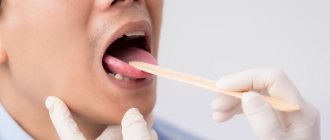Plaque on the tongue itself is not a disease, it is a symptom that reflects what is happening in the body. There are types of plaque on the tongue that indicate a disorder in the functioning of internal organs. These types of plaque are called pathological.
Author:
- Sadykhov Rahim Agalarovich
ENT pathology expert
3.64 (Votes: 14)
Plaque on the tongue itself is not a disease, it is a symptom that reflects what is happening in the body. In this regard, the statement that language is a mirror of our health is quite true. A slight transparent or whitish coating is normal for a healthy adult. It is usually noticeable after sleep and can be easily cleaned with a toothbrush. However, there are other types of plaque that are not so harmless and indicate a disorder in the functioning of internal organs. These are pathological types.
Pathological plaque can be different: the color ranges from thick white to black, dense and sticky in consistency, and has a bad odor. The structure of the language itself may also change. This is the first signal about the onset of the disease, so if you notice uncharacteristic changes in the appearance of your tongue, consult a doctor for a correct diagnosis. Indeed, in this case it is necessary to identify the root cause of this unpleasant manifestation and quickly begin to treat the underlying disease.
What can cause pathological plaque?
The main reason is a malfunction of the internal organs. However, there are two other possibilities: smoking and improper oral hygiene. For active smokers, a yellowish coating is a constant companion, which may not indicate anything bad about health other than the presence of a bad habit. If you don't brush your mouth properly, your tongue will be completely ignored. It is wrong to brush your teeth alone. Bacteria accumulate on the surface of the tongue; they also need to be removed. To clean the tongue, many toothbrush manufacturers make a special brush on the other side. There are also scrapers for the surface of the tongue.
If a person does not smoke and maintains proper hygiene, but there is still plaque, then this may be an indicator of the following diseases:
- Diseases of the digestive system (the most common cause) are ulcers, gastritis, diseases of the gallbladder, pancreas, and liver. Usually in such cases the plaque is accompanied by a persistent unpleasant odor that does not go away even after cleaning.
- Diseases of the respiratory system - tuberculosis, bronchitis, asthma.
- Infectious diseases - influenza, sore throat, ARVI, acute respiratory infections.
- Reduced immunity.
- Diseases of teeth and gums.
- Changes in acid-base balance due to medications.
Tongue position - what does it affect?
The correct position of the tongue is the key to a physiological bite, as well as the absence of problems with swallowing, chewing and speech. Let's look at the main negative consequences that arise when the tongue is positioned incorrectly.
If the tongue is pushed back:
- Swallowing disorder is a disorder in the synchronization between swallowing and breathing.
- Pulling the lower jaw back.
- Dysfunction of the auditory tube.
- Violation of voice formation.
If the tongue is moved forward:
- Swallowing disorder.
- The lower jaw is pulled forward.
- Violation of voice formation.
- Curvature of teeth, especially the front ones.
- Protrusion of the tongue forward.
- Decreased lip tone (up to complete loss).
- Excessive tension transmitted to certain muscles and joints of the dental system.
Symptoms that occur due to improper tongue position include:
- violation of nasal breathing;
- swallowing disorder;
- speech defects;
- neuromotor development disorder;
- symptoms from ENT organs;
- malocclusion and other dental problems;
- dysfunction of the temporomandibular joint (TMJ);
- emotional disturbances.
What color is the pathological plaque?
By the color of the coating on the tongue, you can determine which organ malfunction caused it:
| White | A light whitish coating that can be easily cleaned with hygiene procedures is the norm for an adult. A cause for concern is if the white coating is dense or has a cheesy structure and is not cleaned. This may be a sign of a fungal infection. Other reasons include: monotonous diet, lack of vitamins, poor hygiene, smoking, intoxication, wearing dentures, taking medications. |
| Grey | Sometimes the tongue becomes covered with a gray coating when taking antibiotics for a long time. Also accompanies diseases of the gastrointestinal tract. |
| Yellow | Often indicates liver disease (in such cases a bitter taste is felt in the mouth). It can also occur with diseases of other organs of the digestive tract, with viral diseases, with an excess of bile in the body. |
| Green | This is a rare occurrence. Most often it is an indicator of liver problems. |
| Brown | Occurs with disorders of the digestive tract, alcoholism and smoking, and abuse of brown foods (chocolate, coffee, black tea). |
| Orange | It occurs mainly with gastritis, due to the fact that gastric juice enters the oral cavity in large quantities. |
| Blue | It may appear due to problems in the cardiovascular system, kidneys, due to a lack of folic acid, iron, Vit C, Vit B12. It can also appear due to mercury and heavy metal poisoning. |
| Black | Appears in cases of liver dysfunction, lead poisoning, acute infections, Crohn's disease, acidosis. |
Map of diseases of internal organs by language
Scientists believe that the tip of the tongue is connected to the heart, the central part - to the stomach and pancreas, the back part - to the kidneys, the right lobe of the tongue - to the spleen and right lung, the left - to the liver and left lung. If strong changes occur in any area, it means there are problems with one or another organ.
This map will help you identify tongue disease by color and location.
Redness:
- at the base - impaired renal function;
- in the middle - diseases of the colon;
- at the tip - problems with the cardiovascular system;
- front part - weak lungs, breathing problems;
- the central part is stomach diseases.
Small cracks located throughout the entire area of the mucosa appear with intestinal diseases.
Changes in the fold in the middle of the organ:
- transformation of shape - problems with the spinal column;
- deviation of the fold to the right - back pain;
- deviation to the left – displacement of the cervical vertebrae;
Trembling in the tongue may indicate severe stress or a disorder of the nervous system.
When diagnosing diseases by the color of the tongue, additional symptoms should be taken into account, since the same shade of the tongue characterizes both problems that do not require serious intervention and diseases that require immediate hospitalization.
Diagnostics
To establish a complete picture of the state of the body, the doctor determines the color of the tongue, its structure, position, motor functions, and possible other pathologies in the oral cavity. Among the laboratory and instrumental research methods aimed at clarifying the characteristics of plaque and the reasons for its appearance, the following may be prescribed:
- general and biochemical blood test;
- sowing on flora from the surface of the tongue;
- determination of antibodies to the bacterium Helicobacter pylori;
- Ultrasound of internal organs;
- fibrogastroduodenoscopy;
- scatological research.
If you are concerned about the condition of your tongue, plaque on it, pain, unpleasant odor, contact the ENT doctors of our clinic. High-precision equipment and the experience of our specialists allow us to quickly make correct diagnoses and prescribe treatment.
What a healthy tongue should look like
A healthy tongue should be pink and have a fold along its surface. It should be soft upon palpation and should not hurt when moving in different directions. The taste buds on the organ should be clearly visible. A small amount of white plaque does not always indicate the presence of any pathology; as a rule, this is the norm. A significant accumulation of plaque on the tongue may indicate the development of the following diseases:
- caries;
- gingivitis and other periodontal diseases;
- candidiasis.
Also, the cause of white or yellow plaque can be gastrointestinal diseases, food allergies or lack of vitamins. Plaque thickening may signal a chronic disease.
Localization
Close attention is paid to the site of swelling. The varied nature of the disease harms a specific area of the muscular organ. If the root is affected, problems with the large intestine can be assumed. Pathology in the middle indicates improper functioning of the duodenum or small intestine, as well as the stomach. When imprints of chewing organs are visible on the sides, the patient is advised to balance the diet. More about this.
Along the edges
Is your tongue swollen around the edges? In such a situation, marks from the side teeth are visible on it. This most often occurs when a deficiency of nutrients in the body is diagnosed. Also, the edges are affected when problems with the thyroid gland occur. If water is retained in the body, there will also be dents on the sides of the organ. Most often this is diagnosed in diabetics, with inflammation or enlargement of the liver. It happens that this condition is typical for a diseased spleen, excess weight, and improper digestion.
On one side of the tongue
A symptom such as one-sided swelling due to a certain disease. It can be triggered by various factors: chronic diseases, bacterial or fungal infection, neoplasm, herpes virus and other ailments. It happens that one side swells as a result of injury. This could be a bite, burn, or surgery. Often Quincke's edema or allergies affect a specific area - an area on the right or left side.
Under the tongue
When swelling affects the area under the muscle organ, this most often indicates improper functioning of the salivary glands. Many provoking factors can lead to this condition. Among them are infection, mumps, sand in the salivary glands, HIV, herpes, influenza, poor hygiene, parainfluenza of both types.
Treatment
Professional oral hygiene plays an important role in the overall health of the patient. It should be done regularly in the dentist's office. This is the only way to prevent the disease or provide quick treatment in the initial stages. What to do when a muscle organ is swollen? The cause should be determined and the underlying disease treated.
- In case of glossitis, for example, it is necessary to eliminate the inflammatory process with prescribed medications.
- For hypothyroidism, hormonal therapy is used. First, it is determined which hormones are deficient.
- If a patient has anaphylactic shock, an emergency room should be called immediately.
- Disorders of a genetic nature are treated symptomatically.
Allergic edema
This condition is very life-threatening, especially if it is Quincke's edema. It develops rapidly, instantly spreads to the larynx, cheeks, lips, and it becomes difficult to breathe. Only a doctor can provide professional assistance. It is important to avoid contact with allergens. Therapy is carried out with anti-inflammatory and antihistamine drugs. They block the negative effects of histamines. Suprastin, Loratadine, Tavegil are often prescribed. According to indications, the doctor may prescribe Prednisolone. Miramistin or chlorhexidine solution are used for rinsing. If an allergy occurs after the installation of dentures, you should contact a dentist who will select a safe material.
Infectious swelling
If the swelling is caused by an infection, therapy is given against a specific type of virus or strain of pathogenic bacteria.
- For herpes, a drug such as Acyclovir is used.
- Fungal infections are treated with Clotrimazole, Fluconazole, Flucostat.
- To treat syphilis, antibiotics from the group of tetracyclines or penicillins are needed.
- For scarlet fever, penicillin and antihistamines are prescribed.
If complications arise from secondary infection, therapy is prescribed for infected wounds.
Traumatic edema
A burned or bitten swollen tongue should be treated by a dentist. He will establish an accurate diagnosis and develop a treatment regimen. The area affected by the piercing will heal if the jewelry and inflammation are removed. Constant injury from braces is eliminated by their correction. Infection of the mucous membrane by spicy food is treated with antiseptic agents. Therapy for acid burns is carried out using a disinfectant rinse, as well as lubricating the affected areas with aniline-based paints. Patients are prescribed a solution of dicaine.
Treatment at home
When the muscle organ begins to increase in size, discomfort and unpleasant sensations appear, you should immediately consult a dentist. Healing will accelerate when traditional methods of treatment, agreed upon with the doctor, are added to the main therapy.
- Rinsing with a decoction of chamomile, calendula and sage. The oral cavity is treated with a warm solution several times a day.
- Juice from raw potatoes is used as a rinse. This solution is good at soothing the affected mucous tissues. To prepare, you will need several potatoes, which are crushed in a blender. Then the juice is squeezed out of the pulp through cheesecloth.
- Applying ice wrapped in cloth to the affected area helps.
- Baking soda is an excellent antiseptic. To rinse, it is simply diluted in water.
- A good mouth rinse is dissolved furatsilin tablets (2 pieces per 250 ml of water). The tablets must first be crushed.
When to see a doctor
If the size of the tongue constantly increases and the general condition worsens, you should immediately visit the dentist. In difficult situations, the patient may have difficulty breathing, as well as a sensation of a foreign body in the mouth. Often the mucous tissues become loose, the papillae stand out, and imprints of the masticatory organs appear. The lower part of the tongue is covered with pronounced blood vessels.
Do not delay visiting your doctor if:
- The sense of taste has changed dramatically.
- The mucous membrane has acquired an unusual color.
- There was heaviness when swallowing and chewing.
- Body temperature has increased.
- There is hyperemia of the mucous tissues.
- The skin became pale.
If your tongue hangs out for several days because it does not fit in your mouth, you should not self-medicate and neglect the help of a dentist. You may need to consult a gastroenterologist, therapist, endocrinologist, or infectious disease specialist.
Causes
If a patient has a swollen tongue, the reasons can be very diverse, ranging from a banal injury to a severe allergic reaction. According to the cause, appropriate treatment is prescribed.
If the tongue swells very quickly and at the same time greatly increases in size, then this may be a symptom of a severe allergic reaction. In this case, you should act immediately, since the sensation of a swollen tongue may precede the development of anaphylactic shock. If no measures are taken, the patient may suffocate. So if you have a swollen tongue, allergies are the first reason you should think about.
With allergies, patients usually complain of the following symptoms:
- the tongue hurts and is swollen, as if it does not fit in the mouth;
- lips and tongue are swollen, it is difficult to talk and swallow;
- the papillae on the tongue became swollen, and the tongue itself became painful and sensitive;
- swollen at the base, which makes it difficult to swallow and breathe fully.
Another reason why a patient’s tongue is swollen may be injuries resulting from an incorrect bite, cut, or scratch with hard pieces of food. In this case, the patient usually complains that his tongue is swollen on one left or right side, that is, on the side on which he was injured. In this case, it is important to ensure the cleanliness of the oral cavity and prevent bacteria from entering the wound in order to prevent the occurrence of an inflammatory process.
- If the patient's tongue is swollen on the sides, especially when tooth marks are visible on the side surface, the doctor may suspect thyroid disease. In this case, it is necessary to refer the patient to study the level of thyroid hormones.
- If the patient has swelling under the tongue, this may be a consequence of taking sublingual drugs - those that dissolve under the tongue (validol, engistol and a number of other drugs). In this case, the swelling under the tongue usually goes away on its own after you stop taking the medications.
- Complaints that the tongue is swollen can also occur if the patient has injured the delicate epithelium with sharp pieces of food - for example, chips. In this case, the sensation will go away on its own after brushing your teeth or rinsing your mouth with a tooth elixir or balm.
- Some infections can also lead to swelling of the tongue, in particular streptococcal infection, herpes virus, candidiasis, syphilis. In this case, it not only swells, but also hurts, and small rashes, a dense white coating or ulcers appear on the surface of the mucous membrane, depending on the condition and neglect of the disease.
- The most dangerous reason for a sore throat and swollen tongue is cancer. It is quite rare, but still should not be discounted. Therefore, if the patient has no visible causes of tongue swelling, allergies are excluded, and his condition still does not improve, there is a reason to refer such a patient for a consultation with an oncologist.











